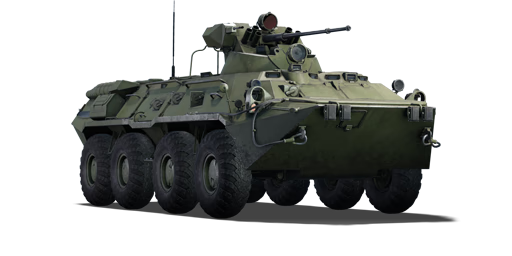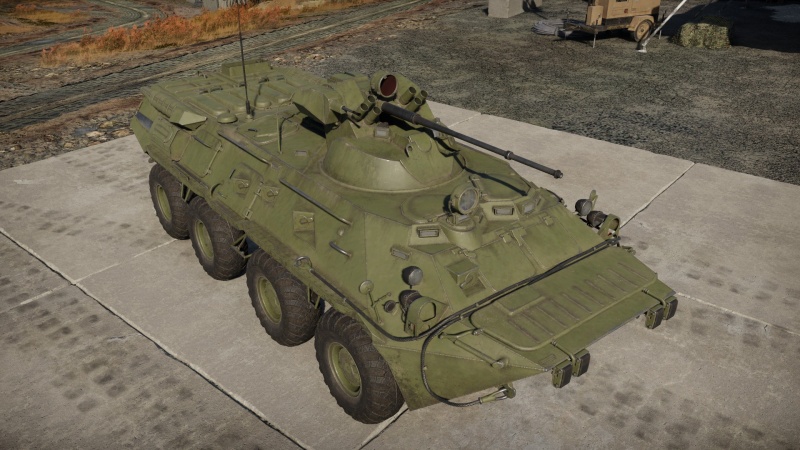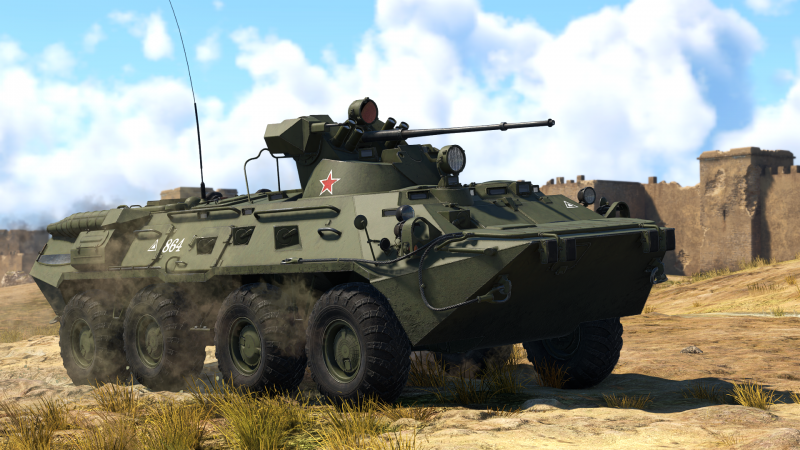Difference between revisions of "BTR-80A"
m (→Usage in battles) (Tag: Visual edit) |
(Mobility description) (Tag: Visual edit) |
||
| Line 37: | Line 37: | ||
=== Mobility === | === Mobility === | ||
{{Specs-Tank-Mobility}} | {{Specs-Tank-Mobility}} | ||
| − | + | While quite large and somewhat heavier than most other light IFVs such as the weisel, It boasts a very high top speed of 87km/h which can be reached quite quickly on roads and trails, but of course the downside of the 8 wheel design being poor offroad mobility however it is still considered quite nimble even on rough ground. It is very common to see BTR-80s rushing caps due to their high speed and with the help of the researchable turret fixed smoke launchers; can capture points quite safely and then reposition to either scout or ambush enemy light/medium armor. | |
{{tankMobility|abMinHp=403|rbMinHp=230}} | {{tankMobility|abMinHp=403|rbMinHp=230}} | ||
Revision as of 17:35, 3 August 2023
Contents
Description
In the post-World War II environment, the Soviet sought to provide their infantry with a method to remain mobile on the battlefield. While armoured units received BMPs to keep the armoured infantry mobile with the tanks, motorizing rifle divisions required a cheaper, more numerous transport to house all the infantry. The BTR series of armoured cars would first be modernized with the 8x8 wheeled BTR-60 in the 1960s, with updates into the BTR-70 and BTR-80 in their respective decades. The BTR-80 was distinguished from the preceding two variants with the usage of a diesel engine and turret modifications that allowed it to elevate the main armament to a high degree to engage in mountainous terrain or urban areas. The BTR-80 would receive an update in the 1990s that added the 30 mm 2A72 autocannon as its main armament in a new turret designated BPPU.
The BTR-80A, introduced in Update "La Royale", follows the trend of a light tank with an autocannon armament that can shred apart medium tanks in ambushes. Unlike its contemporaries like the Wiesel 1A4, the BTR-80A is a rather large vehicle, quite similar to the BMPs. Not to mention the wheeled design can interfere with cross-country mobility so that finding a good place to hide outside of urban terrain can be difficult. As such, finding a suitable hiding place to ambush the enemies with the autocannon can be complicated by the BTR-80A's size and wheeled performance. That said, the 30 mm 2A72 autocannon that is found on the BMP-3 packs a much higher punch with its APDS rounds. This allows the BTR-80A the ability to attack more enemies from a farther away distance with the 30 mm and should be exploited by watching common enemy travel routes from a distance to riddle their side armour to shreds.
General info
Survivability and armour
Describe armour protection. Note the most well protected and key weak areas. Appreciate the layout of modules as well as the number and location of crew members. Is the level of armour protection sufficient, is the placement of modules helpful for survival in combat? If necessary use a visual template to indicate the most secure and weak zones of the armour.
Armour type:
| Armour | Front (Slope angle) | Sides | Rear | Roof |
|---|---|---|---|---|
| Hull | ___ mm | ___ mm Top ___ mm Bottom |
___ mm | ___ - ___ mm |
| Turret | ___ - ___ mm Turret front ___ mm Gun mantlet |
___ - ___ mm | ___ - ___ mm | ___ - ___ mm |
| Cupola | ___ mm | ___ mm | ___ mm | ___ mm |
Notes:
Mobility
While quite large and somewhat heavier than most other light IFVs such as the weisel, It boasts a very high top speed of 87km/h which can be reached quite quickly on roads and trails, but of course the downside of the 8 wheel design being poor offroad mobility however it is still considered quite nimble even on rough ground. It is very common to see BTR-80s rushing caps due to their high speed and with the help of the researchable turret fixed smoke launchers; can capture points quite safely and then reposition to either scout or ambush enemy light/medium armor.
| Game Mode | Max Speed (km/h) | Weight (tons) | Engine power (horsepower) | Power-to-weight ratio (hp/ton) | |||
|---|---|---|---|---|---|---|---|
| Forward | Reverse | Stock | Upgraded | Stock | Upgraded | ||
| Arcade | 97 | 14 | 14.6 | 403 | 496 | 27.6 | 33.97 |
| Realistic | 87 | 12 | 230 | 260 | 15.75 | 17.81 | |
Modifications and economy
Armaments
Main armament
| 30 mm 2A72 | Turret rotation speed (°/s) | Reloading rate (seconds) | ||||||||||||
|---|---|---|---|---|---|---|---|---|---|---|---|---|---|---|
| Mode | Capacity (Belt) | Fire rate | Vertical | Horizontal | Stabilizer | Stock | Upgraded | Full | Expert | Aced | Stock | Full | Expert | Aced |
| Arcade | 300 (150) | 330 | -5°/+70° | ±180° | - | 28.6 | 39.5 | 48.0 | 53.1 | 56.5 | 1.30 | 1.15 | 1.06 | 1.00 |
| Realistic | 17.9 | 21.0 | 25.5 | 28.2 | 30.0 | |||||||||
Ammunition
- Default: AP-T · HEF-I* · AP-T · HEF-I*
- 30 mm HEI: HEF-I* · HEF-I* · HEF-I* · AP-T
- 30 mm APT: AP-T · AP-T · AP-T · HEF-T*
- 30 mm APDS: APDS · APDS · APDS · APDS · HEF-T*
| Penetration statistics | |||||||
|---|---|---|---|---|---|---|---|
| Ammunition | Penetration @ 0° Angle of Attack (mm) | ||||||
| 10 m | 100 m | 500 m | 1,000 m | 1,500 m | 2,000 m | ||
| HEF-I* | 8 | 7 | 6 | 5 | 4 | 3 | |
| AP-T | 65 | 63 | 53 | 44 | 36 | 29 | |
| HEF-T* | 9 | 8 | 7 | 5 | 4 | 3 | |
| APDS | 82 | 81 | 79 | 75 | 72 | 69 | |
| Shell details | ||||||||||||
|---|---|---|---|---|---|---|---|---|---|---|---|---|
| Ammunition | Velocity (m/s) |
Projectile mass (kg) |
Fuse delay (m) |
Fuse sensitivity (mm) |
Explosive mass (TNT equivalent) (g) |
Ricochet | ||||||
| 0% | 50% | 100% | ||||||||||
| HEF-I* | 960 | 0.39 | 0.1 | 0.1 | 75.46 | 79° | 80° | 81° | ||||
| AP-T | 970 | 0.4 | - | - | - | 47° | 60° | 65° | ||||
| HEF-T* | 960 | 0.39 | 0.1 | 0.1 | 17.86 | 79° | 80° | 81° | ||||
| APDS | 1,120 | 0.3 | - | - | - | 75° | 78° | 80° | ||||
Ammo racks
| Full ammo |
1st rack empty |
2nd rack empty |
3rd rack empty |
4th rack empty |
5th rack empty |
6th rack empty |
Visual discrepancy |
|---|---|---|---|---|---|---|---|
| 2 | __ (+__) | __ (+__) | __ (+__) | __ (+__) | __ (+__) | __ (+__) | __ |
Machine guns
| 7.62 mm PKT | ||||
|---|---|---|---|---|
| Mount | Capacity (Belt) | Fire rate | Vertical | Horizontal |
| Coaxial | 2,000 (250) | 700 | - | - |
Usage in battles
Describe the tactics of playing in the vehicle, the features of using vehicles in the team and advice on tactics. Refrain from creating a "guide" - do not impose a single point of view but instead give the reader food for thought. Describe the most dangerous enemies and give recommendations on fighting them. If necessary, note the specifics of the game in different modes (AB, RB, SB).
Pros and cons
Pros:
- Effective 2A72 30mm autocannon, the same one used on the BMP-3 and BMD-4
- APDS is great for fighting against light vehicles and MBTs' sides
- Fairly mobile and thus very good at flanking
- Amphibious
Cons:
- Huge profile
- Poor survivability due to thin armour, minimal crew number and large size
- -5° gun depression and slow gun handling
- Has no stabiliser
- Relatively low power-to-weight ratio
History
The BTR-80 armored personnel carrier was developed with experience from using the previous vehicles of the series, BTR-60 and BTR-70, in peacetime and combat operations of the Afghan war. The vehicle received a new 260 hp engine, reinforced armor, improved fire ports for the small arms of the troops inside, as well as other improvements. The main gun of the BTR-80 remained a heavy machine gun, however, due to the low efficiency of machine gun fire against modern lightly armored targets, an improved version of the vehicle with a 30mm 2A72 autocannon appeared in 1993, designated as BTR-80A. Vehicles of the BTR-80 family took part in all major armed conflicts in the territory of the former USSR and a number of other countries. Despite the commissioning of more advanced APCs, the BTR-80A is still in service with the Russian Army to this day.
- From Devblog
Media
- Skins
See also
Links to the articles on the War Thunder Wiki that you think will be useful for the reader, for example:
- reference to the series of the vehicles;
- links to approximate analogues of other nations and research trees.
External links
| USSR light tanks | |
|---|---|
| T-26 | T-26 · T-26 (1st Gv.T.Br.) · T-26-4 · T-26E |
| BT | BT-5 · RBT-5 · BT-7 · BT-7 TD · BT-7M · BT-7A (F-32) |
| T-50 | T-126 · T-50 |
| T-70 | T-70 · T-80 |
| PT-76 | PT-76B · PT-76-57 · Object 906 |
| BMP | BMP-1 · BMP-2 · BMP-2M · BMP-3 |
| BMD | BMD-4 |
| 2S25 | 2S25 · 2S25M |
| Wheeled | BA-11 · BTR-80A |
| Other | T-60 · Object 685 · 2S38 |
| China | ▂Type 62 |






